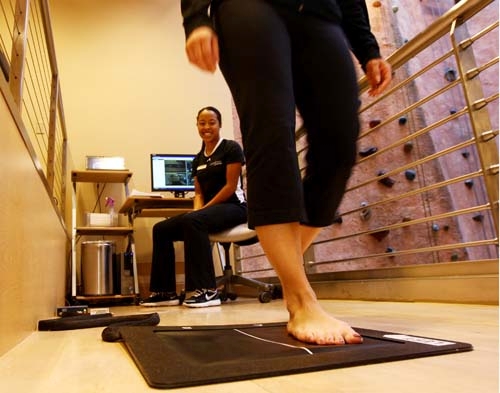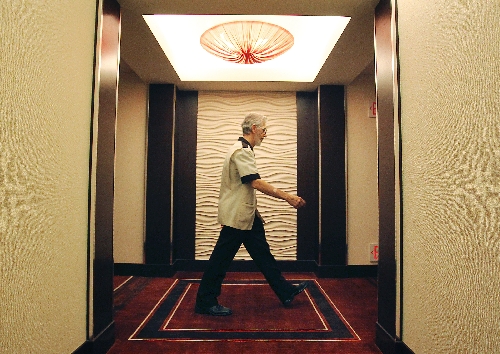Keeping in step: Foot problems common in service industry
Consider the human foot.
Its 26 bones, 20 muscles and more than 150 ligaments make it one of the most complex anatomical structures of the body. A pair of them takes an average of 10,000 steps a day, absorbing the cumulative force of hundreds of tons.
And nowhere are feet more important than in a town with a large service industry like Las Vegas.
"Oh yes, my feet are very important to my career," says Colin Shaughnessy, a valet supervisor at Green Valley Ranch Resort. "I learned that pretty quick."
Yet, feet are perhaps the most overlooked, underappreciated body parts, says orthopedic foot and ankle surgeon Roman Sibel.
Until they hurt.
"Every aspect of your daily life revolves around your feet," Sibel says. About 50 percent of his patients see him for work-related foot and ankle injuries. "I don't think people understand the magnitude of change in life if they can't walk well. It affects everything from getting up to making breakfast and going to work."
Service industry workers, including cocktail servers, valet runners, cashiers, restaurant workers, dealers and performers, are more susceptible to foot and ankle problems than those in other jobs for two reasons: footwear and time spent on their feet.
"They're not doing desk jobs, they're spending a lot of time walking back and forth," Sibel says. "They're typically wearing a uniform shoe. For women, it's often a high heel."
Leisa Glans, a cocktail server at Red Rock Resort, started her cocktail career at Imperial Palace 17 years ago. She was required to wear three-inch heels; at Red Rock, it's a two-inch heel.
"I'm from Oklahoma, so I never wore high heels," Glans says. "But for that first year, going from sandals to three-inch heels, that was painful. I think my foot just wasn't used to being in that position for eight hours."
Now, however, her feet are used to the shoes and the activity, so she rarely has problems with her feet.
Sibel sees two kinds of foot and ankle problems: acute and chronic. Arthritis is the most common chronic issue. Ankle sprains are the most common acute complaints, he says, and many patients are women who wear high heels for their jobs. Or they're dancers and performers who don't wear supportive footwear.
"I can't stress the importance of good shoes," says Rich O'Baid, a bellman at Red Rock Resort. He started out at Boulder Station 14 years ago. "Before I got the job, someone said a bellman needs good shoes."
For years, O'Baid has worn Rockports; they're athletic but a little dressy. They give him support around the ankles, too. A good pair of shoes lasts him at least six months, he says. A few months ago, he came across a nice pair of shoes at the store and bought them. They weren't Rockports but they felt and looked good.
"After a few months I could feel my feet aching," he says. A giant callus developed on the ball of his left foot. "It really hurt a lot."
He visited a doctor, who shaved the callus off and gave him some ointment to apply. It's better now, but his experience has made him even more aware of the need to take care of his feet.
When Shaughnessy started out as a valet 17 years ago, he wore a cool pair of basketball sneakers for his first week on the job. His feet and then his knees hurt so much, he thought he would have to return to his restaurant job.
Feet are not supposed to hurt, says podiatrist Lawrence Rubin. Retired from his practice, Rubin heads a nonprofit called Lower Extremity Amputation Prevention, or LEAP. He also taught podiatry. Now, he works to prevent foot and lower leg amputations by promoting annual foot exams, especially in diabetics. Diabetes makes people susceptible to foot problems because of loss of nerve sensation.
People tend to ignore foot problems until they get so bad they're hard to heal, Rubin says.
"When there are symptoms and people have painful feet, they think it's normal for them to hurt. They think it's because they're getting older or they've been told they have flat feet. Under none of those circumstances should they hurt," Rubin says.
Podiatrists, foot specialists who are physicians but not medical doctors, see a host of problems, including nail fungus, ingrown toenails, hammer toe, bunions, plantar fasciitis and inflammatory joint disease, Rubin says.
People who get bunions, a bump on the big toe joint, or hammer toe, a clawlike big toe, are genetically predisposed to them, Rubin says. Usually, sufferers have to wear shoes that will accommodate the physiology of their feet. In extreme circumstance, surgery can correct both problems.
Treatments for most foot problems vary from conservative -- anti-inflammatories and crutches -- to surgery, depending on the complaint. Orthotics help in some instances, both Sibel and Rubin say. Even shoes such as Sketchers Shape-Ups can assist in a patient's rehabilitation or the prevention of some problems such as plantar fasciitis, Sibel says.
The key to most foot problems is preventing them, especially if your job requires you to be on your feet, Rubin and Sibel agree.
Wearing the right shoes is important. Avoid high heels if you can, Sibel says. Also, rotate your shoes. Try not to wear the same pair two days in a row. This enables them to air out, preventing fungi from spreading, Sibel says. Also, only wear your work shoes to work.
Foot exams are important, too, Rubin says. Look for blisters, calluses, discolored nails or other abnormalities. It's normal for your feet to ache a bit after extended use, but if pain persists, go to a foot specialist, he adds. Sometimes, over-the-counter remedies work. Sometimes they don't.
"Let's put it this way. We live in Las Vegas and our feet are hurting and the hurt doesn't go away," Rubin says. "Now we could do one of two things. We could go to the expert to tell us what's wrong. The odds are, you're on the right track. On the other hand, I might say I don't want to go to the doctor, I want to try something else first. The odds are not as good that you will find the exact correct solution. There is some risk that what you're going to do will take up valuable time and money and not solve your problem. On the other hand, you might get lucky."
Contact reporter Sonya Padgett at spadgett@ reviewjournal.com or 702-380-4564.
Signs of Trouble
Podiatrist Lawrence Rubin says there are several signs that you should see a doctor about your feet:
■ You have excruciating pain when you get out of bed in the morning; could be plantar fasciitis, or inflammation of the connective tissue on the bottom of the foot.
■ The ball of your foot hurts; could be inflammatory joint disease or arthritis.
■ You have discolored nails; yellow streaking in the nails could be fungus while blue streaks could be melanoma.
■ You have poor circulation in your feet, sores or blisters that won't heal; could be an indication of diabetes.


















